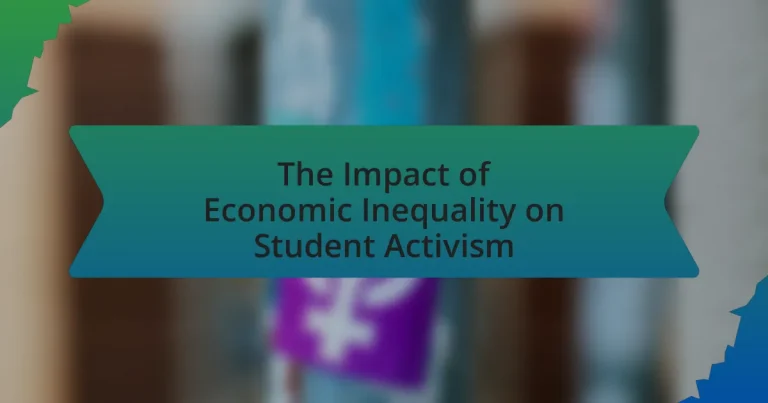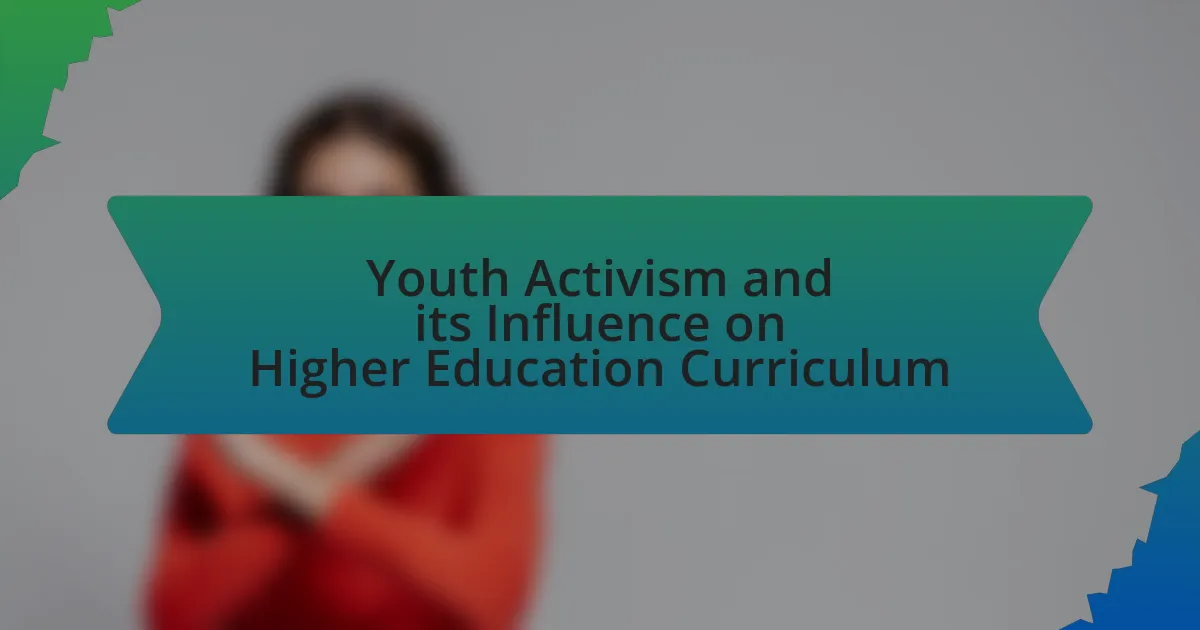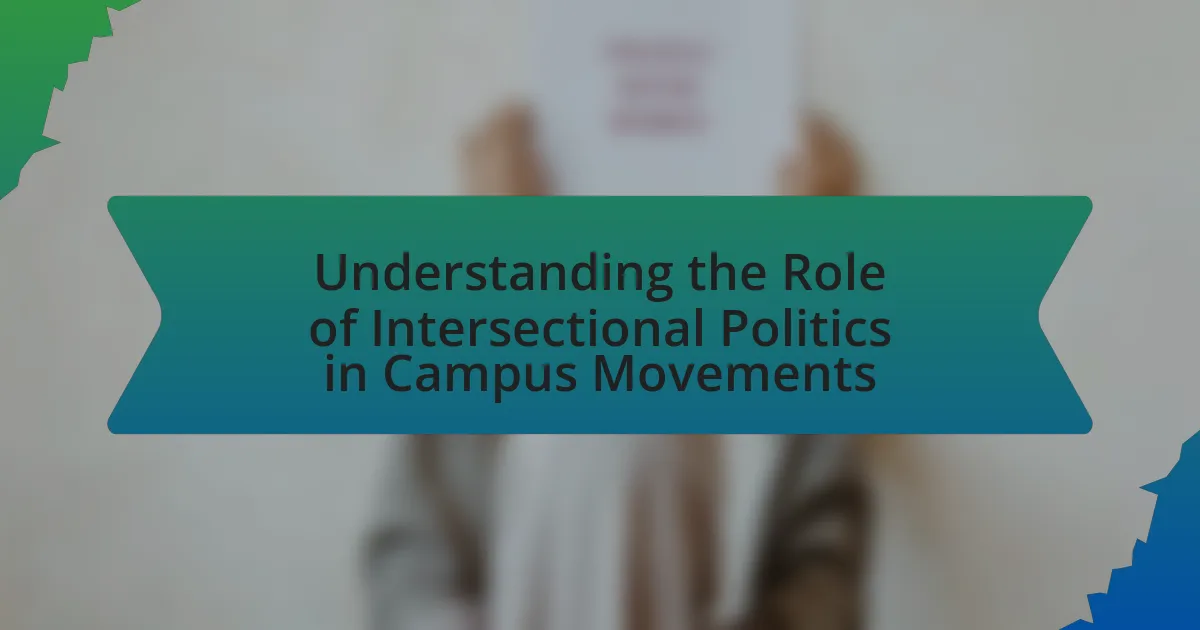The article examines the impact of economic inequality on student activism, highlighting how disparities in socioeconomic status shape students’ motivations, engagement, and experiences in advocacy. It discusses the barriers faced by students from lower-income backgrounds, the historical context of activism related to economic issues, and the evolution of student movements over time. Key factors linking economic inequality to activism include access to education, social mobility, and political engagement, while current trends focus on issues such as affordable education, student debt relief, and mental health resources. The article emphasizes the importance of understanding these dynamics for educational institutions and outlines strategies for effective student advocacy.
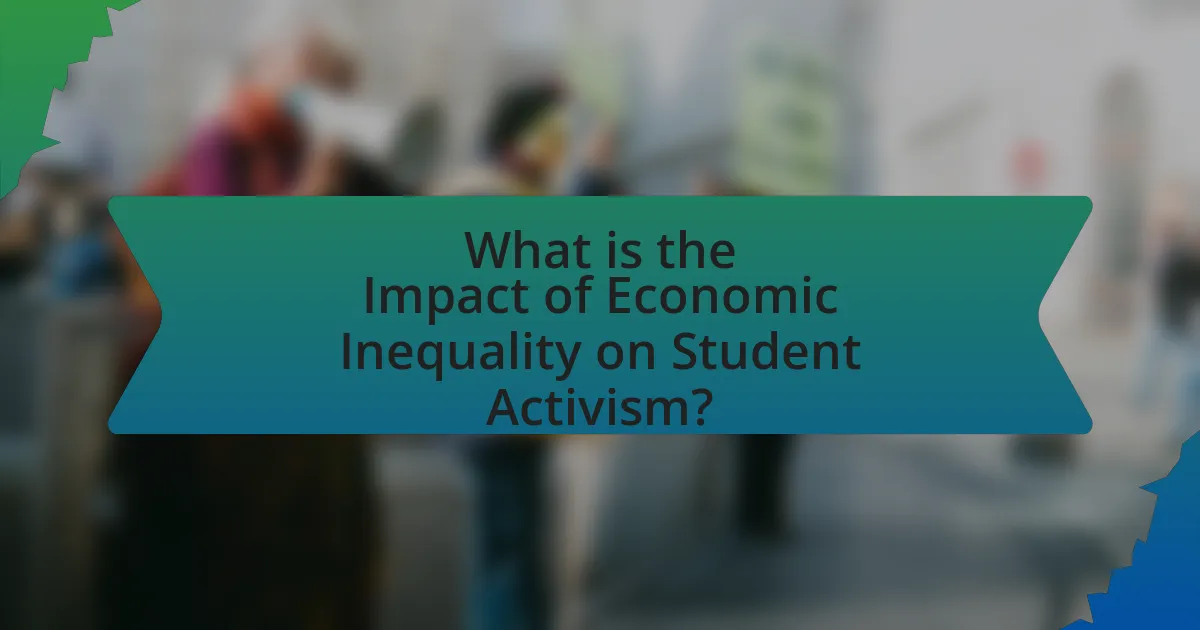
What is the Impact of Economic Inequality on Student Activism?
Economic inequality significantly influences student activism by shaping the priorities and motivations of students. Students from lower socioeconomic backgrounds often engage in activism to address issues such as tuition affordability, access to resources, and systemic injustices that affect their educational opportunities. Research indicates that economic disparities can lead to heightened awareness and mobilization around social justice issues, as seen in movements advocating for affordable education and equitable funding for schools. For instance, the 2015 “Fight for $15” campaign, which sought to raise the minimum wage, was largely supported by student activists who recognized the impact of economic inequality on their peers’ ability to afford education. This connection between economic conditions and activism underscores how disparities can galvanize students to advocate for change, making economic inequality a critical factor in the landscape of student activism.
How does economic inequality influence student engagement in activism?
Economic inequality significantly influences student engagement in activism by creating disparities in access to resources and opportunities for participation. Students from lower socioeconomic backgrounds often face barriers such as financial constraints, limited access to information, and fewer connections to activist networks, which can hinder their ability to engage in activism. Research indicates that students from wealthier backgrounds are more likely to participate in organized activism due to greater access to education, social capital, and financial support, allowing them to mobilize more effectively. For instance, a study by the Pew Research Center found that 70% of college students from higher-income families reported participating in activism compared to only 40% from lower-income families, highlighting the impact of economic status on engagement levels.
What are the key factors linking economic inequality and student activism?
Economic inequality significantly influences student activism through factors such as access to education, social mobility, and political engagement. Students from lower socioeconomic backgrounds often face barriers to educational opportunities, leading to heightened awareness of systemic injustices and motivating them to advocate for change. Research indicates that economic disparities correlate with increased activism; for instance, a study by the Pew Research Center found that students from economically disadvantaged families are more likely to participate in protests and movements addressing inequality. Additionally, economic inequality fosters a sense of urgency among students to address issues like tuition costs and student debt, further driving their activism.
How do socioeconomic backgrounds shape students’ activism experiences?
Socioeconomic backgrounds significantly shape students’ activism experiences by influencing their access to resources, networks, and opportunities for engagement. Students from higher socioeconomic backgrounds often have greater access to financial support, educational resources, and social capital, which can facilitate their participation in activism through organized groups, events, and campaigns. Conversely, students from lower socioeconomic backgrounds may face barriers such as limited access to transportation, fewer connections to activist networks, and financial constraints that hinder their ability to engage fully in activism. Research indicates that socioeconomic disparities can lead to differences in the types of issues students prioritize, with those from lower-income backgrounds often focusing on immediate social justice issues that directly affect their communities, while their higher-income peers may engage in broader or more abstract causes. This dynamic illustrates how socioeconomic status not only affects participation levels but also shapes the focus and nature of activism among students.
Why is understanding this impact important for educational institutions?
Understanding the impact of economic inequality on student activism is crucial for educational institutions because it directly influences student engagement and institutional policies. When educational institutions recognize how economic disparities affect student voices and activism, they can create more inclusive environments that address the needs of all students. Research indicates that students from lower socioeconomic backgrounds are often more motivated to engage in activism as a response to perceived injustices, which can lead to significant changes in campus culture and policy. By understanding this dynamic, institutions can better support diverse student populations, enhance educational equity, and foster a more active and informed student body.
What role do universities play in addressing economic inequality?
Universities play a critical role in addressing economic inequality by providing access to education and resources that can uplift marginalized communities. They offer scholarships, financial aid, and outreach programs aimed at low-income students, which help to reduce barriers to higher education. For instance, according to the National Center for Education Statistics, institutions that implement robust financial aid programs significantly increase enrollment rates among economically disadvantaged students. Additionally, universities often engage in research and community service initiatives that target economic disparities, further contributing to social mobility and economic equity.
How can educational policies be influenced by student activism related to economic inequality?
Student activism related to economic inequality can significantly influence educational policies by mobilizing public opinion and pressuring decision-makers to address disparities. For instance, movements like the “Fight for $15” have highlighted the need for equitable funding in education, leading to policy changes in various states that increase funding for low-income schools. Research from the National Education Association indicates that states with active student-led campaigns have seen a 20% increase in funding allocations aimed at reducing economic disparities in education. This demonstrates that organized student efforts can effectively shape policy discussions and outcomes regarding educational equity.
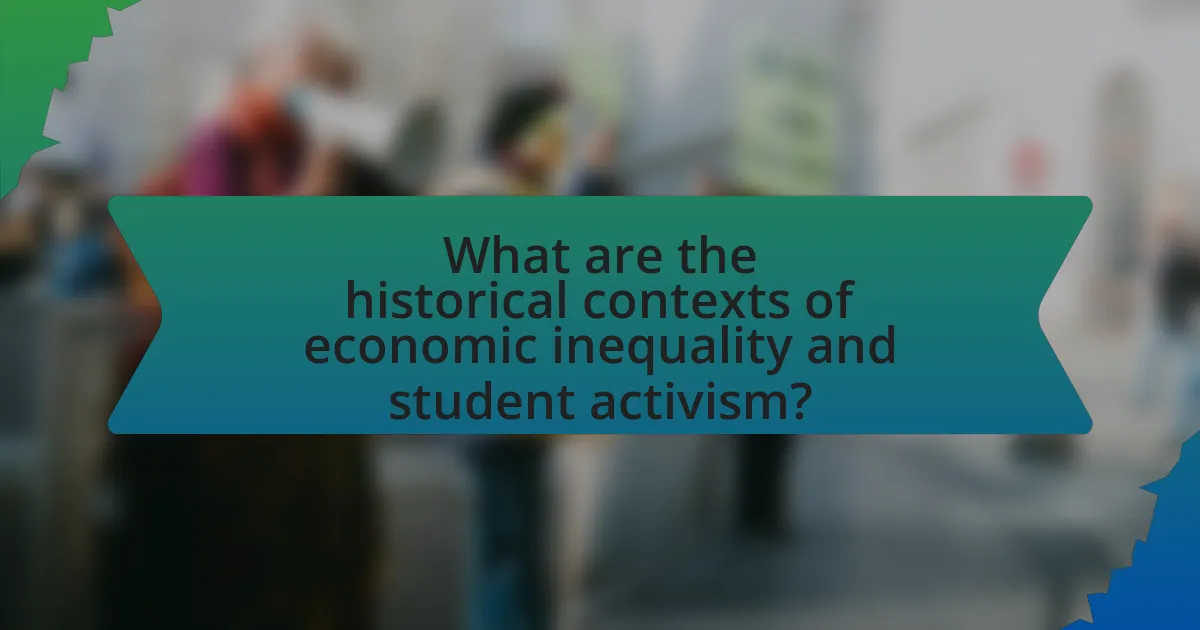
What are the historical contexts of economic inequality and student activism?
Economic inequality has historically influenced student activism, particularly during periods of social upheaval and economic distress. For instance, the Great Depression in the 1930s led to widespread poverty and unemployment, prompting students to mobilize for social justice and economic reforms. Similarly, the Civil Rights Movement in the 1960s saw students advocating against racial and economic disparities, as they recognized the interconnectedness of social justice and economic equity. The Occupy Wall Street movement in 2011 further exemplified this relationship, as students joined protests against the 1% and economic inequality, highlighting the growing divide in wealth distribution. These historical contexts demonstrate that economic inequality often serves as a catalyst for student activism, driving collective action aimed at addressing systemic injustices.
How has student activism evolved in response to economic inequality over time?
Student activism has evolved significantly in response to economic inequality, transitioning from localized protests to global movements. Initially, in the 1960s, student activism focused on civil rights and anti-war efforts, addressing immediate economic disparities within the context of broader social justice. Over time, particularly in the 1980s and 1990s, activism began to incorporate issues like tuition hikes and student debt, reflecting growing concerns about access to education as a result of economic inequality.
In the 21st century, movements such as Occupy Wall Street and the Fight for $15 have highlighted the intersection of economic inequality and social justice, with students playing a crucial role in advocating for systemic change. The rise of social media has further amplified these efforts, allowing for rapid organization and dissemination of information, thus broadening the reach and impact of student activism. This evolution demonstrates a shift from reactive measures to proactive, organized campaigns aimed at addressing the root causes of economic inequality.
What significant movements have emerged from economic disparities?
Significant movements that have emerged from economic disparities include the Occupy Wall Street movement and the Fight for $15 campaign. Occupy Wall Street, which began in 2011, highlighted the growing wealth gap and corporate influence in politics, mobilizing thousands to protest against economic inequality. The Fight for $15 campaign, initiated in 2012, advocates for a $15 minimum wage and better working conditions, reflecting the struggles of low-wage workers facing economic hardship. Both movements illustrate how economic disparities can galvanize collective action and demand systemic change.
How have historical events shaped current student activism trends?
Historical events have significantly shaped current student activism trends by influencing the issues students prioritize and the methods they employ. For instance, the civil rights movement of the 1960s galvanized students to advocate for social justice, leading to a legacy of activism focused on equality and human rights. Similarly, the anti-Vietnam War protests highlighted the role of youth in political discourse, encouraging contemporary movements to utilize similar tactics such as organized protests and social media campaigns. The 2008 financial crisis further intensified student activism around economic inequality, as rising tuition costs and student debt became central issues, prompting movements like Occupy Wall Street and the fight for free college education. These historical contexts demonstrate how past struggles inform current student activism, shaping both the themes of advocacy and the strategies employed by students today.
What lessons can be learned from past student activism movements?
Past student activism movements demonstrate the importance of collective organization and the power of youth voices in driving social change. Historical examples, such as the Civil Rights Movement in the 1960s, show that when students unite around a common cause, they can effectively challenge systemic injustices, as seen in the role of student-led protests in desegregating schools and advocating for voting rights. Additionally, the anti-Vietnam War protests highlight the effectiveness of strategic communication and mobilization, where students utilized media to amplify their messages and garner public support. These movements also reveal that sustained activism often requires adaptability and resilience, as seen in the ongoing struggles for climate justice, where student groups continuously evolve their strategies to address new challenges.
How did previous movements successfully address economic inequality?
Previous movements successfully addressed economic inequality through policy reforms, grassroots organizing, and advocacy for social justice. For instance, the labor movement in the early 20th century fought for workers’ rights, leading to the establishment of minimum wage laws and labor protections, which significantly reduced income disparities. The Civil Rights Movement also played a crucial role by advocating for equal access to education and employment, resulting in legislation like the Civil Rights Act of 1964, which aimed to eliminate discrimination and promote economic opportunities for marginalized groups. These movements utilized collective action and public awareness campaigns to highlight economic injustices, ultimately influencing government policies and societal norms that contributed to a more equitable distribution of resources.
What challenges did past activists face in their efforts?
Past activists faced significant challenges, including repression from authorities, lack of resources, and societal opposition. Repression manifested through arrests, violence, and legal barriers aimed at suppressing their movements, as seen during the Civil Rights Movement when activists were often met with police brutality. Additionally, activists frequently struggled with limited financial support and access to communication tools, which hindered their ability to organize effectively. Societal opposition also posed a challenge, as many activists encountered hostility from segments of the public who disagreed with their goals, exemplified by the backlash against anti-war protests in the 1960s. These factors collectively impeded the progress of their efforts.
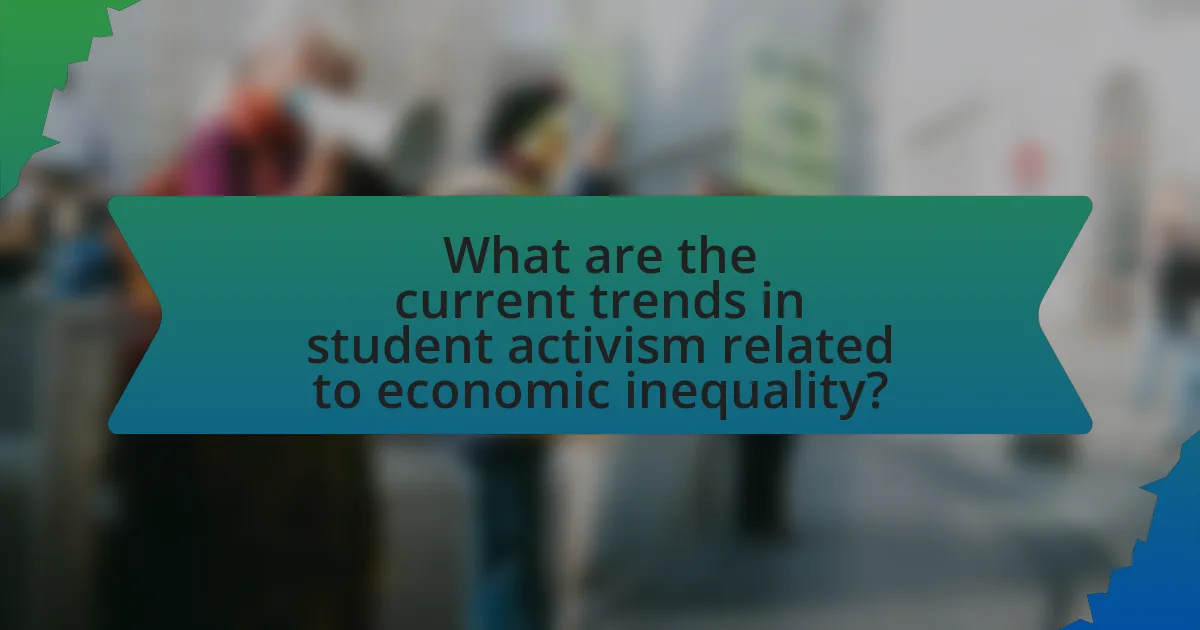
What are the current trends in student activism related to economic inequality?
Current trends in student activism related to economic inequality include a significant focus on advocating for affordable education, student debt relief, and equitable access to resources. Students are increasingly organizing protests and campaigns aimed at reducing tuition fees and addressing the burden of student loans, which collectively exceed $1.7 trillion in the United States. Additionally, there is a growing emphasis on intersectionality, where student activists highlight how economic inequality intersects with issues of race, gender, and class, thereby broadening the scope of their activism. This trend is evidenced by movements such as the “Cancel Student Debt” campaign, which has garnered widespread support among students and has influenced policy discussions at both state and federal levels.
How are modern students mobilizing around issues of economic inequality?
Modern students are mobilizing around issues of economic inequality through organized protests, social media campaigns, and advocacy for policy changes. For instance, student-led movements like the “Fight for $15” campaign have successfully pushed for higher minimum wages, highlighting the disparities in income and living standards. Additionally, platforms such as Instagram and Twitter are utilized to raise awareness and foster community engagement, allowing students to share personal stories and mobilize support for initiatives aimed at reducing economic disparities. Research from the Pew Research Center indicates that 70% of young adults believe that economic inequality is a significant issue, further motivating collective action among students.
What platforms are students using to advocate for change?
Students are using social media platforms such as Twitter, Instagram, and TikTok to advocate for change. These platforms enable students to share their messages widely, mobilize support, and organize events. For instance, Twitter has been instrumental in trending hashtags related to social justice movements, while Instagram allows for visual storytelling that resonates with younger audiences. TikTok’s short video format has also become a popular medium for students to express their views creatively and engage peers in activism.
How do social media and technology impact student activism today?
Social media and technology significantly enhance student activism today by facilitating rapid communication and mobilization. Platforms like Twitter and Instagram allow students to share information, organize events, and raise awareness about social issues in real-time, reaching a global audience instantly. For instance, the #BlackLivesMatter movement gained momentum through social media, with students playing a crucial role in organizing protests and disseminating information. Research from the Pew Research Center indicates that 72% of teens use social media, making it a vital tool for activism. Additionally, technology enables the creation of online petitions and crowdfunding campaigns, further empowering students to advocate for change effectively.
What specific issues are students currently advocating for?
Students are currently advocating for issues such as affordable education, student debt relief, mental health resources, and climate action. These advocacy efforts are driven by the rising costs of tuition, which have increased by over 200% in the last two decades, leading to significant student debt burdens that average around $30,000 per graduate. Additionally, students are pushing for enhanced mental health services on campuses, as studies indicate that nearly 40% of college students report experiencing anxiety or depression. Climate action is also a priority, with students demanding institutions commit to sustainability practices and divest from fossil fuels, reflecting a broader concern about the environmental impact of economic inequality.
How do tuition fees and student debt relate to economic inequality?
Tuition fees and student debt significantly contribute to economic inequality by creating barriers to higher education for low-income individuals. As tuition costs rise, students from wealthier backgrounds are more likely to afford college without incurring substantial debt, while those from lower-income families often rely on loans, leading to long-term financial burdens. According to the Federal Reserve, as of 2021, student loan debt in the United States exceeded $1.7 trillion, disproportionately affecting marginalized communities and perpetuating wealth gaps. This cycle of debt limits economic mobility and reinforces existing inequalities, as graduates with high debt levels may delay homeownership, retirement savings, and other investments that contribute to economic stability.
What role does access to resources play in student activism efforts?
Access to resources significantly enhances student activism efforts by providing the necessary tools, information, and support for effective mobilization. When students have access to financial resources, educational materials, and organizational networks, they can better plan, execute, and sustain their activism initiatives. For instance, research indicates that universities with robust funding for student organizations see higher levels of engagement and successful campaigns, as these resources allow for outreach, event hosting, and collaboration with external partners. Additionally, access to technology and communication platforms enables students to disseminate information rapidly and coordinate actions efficiently, amplifying their impact.
What strategies can students employ to enhance their activism?
Students can enhance their activism by organizing collaborative events that raise awareness about economic inequality. Collaborative events, such as workshops, rallies, and discussions, create a platform for students to share knowledge and mobilize support. Research indicates that collective action significantly increases the visibility and impact of social movements; for instance, the 2011 Occupy Wall Street movement effectively highlighted economic disparities through mass gatherings and coordinated efforts. By leveraging social media for outreach and engagement, students can also amplify their messages and connect with broader audiences, as demonstrated by the success of various online campaigns that have mobilized thousands for social causes.
How can collaboration with community organizations strengthen student movements?
Collaboration with community organizations can strengthen student movements by providing essential resources, expertise, and broader networks that enhance advocacy efforts. When students partner with local organizations, they gain access to funding, mentorship, and training opportunities that can amplify their initiatives. For instance, a study by the National Youth Leadership Council found that student-led projects in collaboration with community groups resulted in a 30% increase in engagement and effectiveness in addressing local issues. This partnership not only empowers students but also aligns their goals with community needs, fostering a more impactful and sustainable movement.
What best practices can students adopt for effective advocacy?
Students can adopt several best practices for effective advocacy, including thorough research, clear communication, and coalition-building. Conducting comprehensive research allows students to understand the issues deeply, which enhances their credibility and effectiveness when presenting arguments. Clear communication, both written and verbal, ensures that messages resonate with diverse audiences, making advocacy efforts more impactful. Additionally, building coalitions with like-minded individuals and organizations amplifies voices and resources, increasing the likelihood of achieving advocacy goals. These practices are supported by studies indicating that well-informed and organized advocacy efforts lead to greater success in influencing policy and public opinion.
